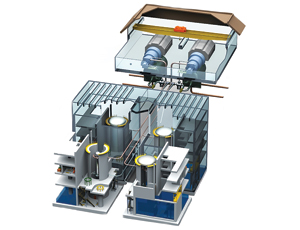Citing a need for smaller and more affordable nuclear reactors, Babcock & Wilcox Co. is developing a self-contained, modular 125-MW nuclear reactor to be built in its U.S. plants and shipped by rail to construction sites.
B&W would like to secure turnkey contracts with utilities to manufacture and install the reactors, says Christofer Mowry, president and chief executive officer of the new Lynchburg, Va.-based division of Babcock & Wilcox, B&W Modular Nuclear Energy LLC.

An array of the 15-ft-dia x 75-ft-tall modules could create small and mid-sized nuclear plants. The B&W-designed reactor, dubbed mPower, will be a passively safe advanced light-water reactor with an underground containment structure. The design will include a fuel pond large enough to store all fuel used during the unit’s 60-year lifetime. The units have a five-year fuel cycle.
B&W for years has built small nuclear powerplants for ships and submarines. It now joins Shaw Group, Baton Rouge; NuScale Power, Corvallis, Ore.; GE Nuclear, Wilmington, N.C.; Westinghouse Electric Co., Monroeville, Pa.; Hyperion Power Generation Inc., Santa Fe, N.M., and Japan-based Toshiba and Hitachi, all of which have told the Nuclear Regulatory Commission they intend to develop small-scale units.
Mowry would not give costs for B&W units but says the high cost of nuclear licensing will be offset by lower costs of being able to control the construction of the reactors within the company’s facilities. Because the reactor is smaller, B&W can manufacture all components of its nuclear steam-supply system, including forgings for the reactor, he says.
B&W has a memorandum of understanding with the Tennessee Valley Authority and a consortium of regional municipal and cooperative utilities to explore construction of a fleet of mPower reactors. The company plans to file for design certification with NRC in 2011. The first reactors could be on line by 2018.
There is a lot of potential for such smaller units because they would be more affordable and financing would be easier to secure, says Tom Kauffman, a spokesman for the Nuclear Energy Institute.

Post a comment to this article
Report Abusive Comment